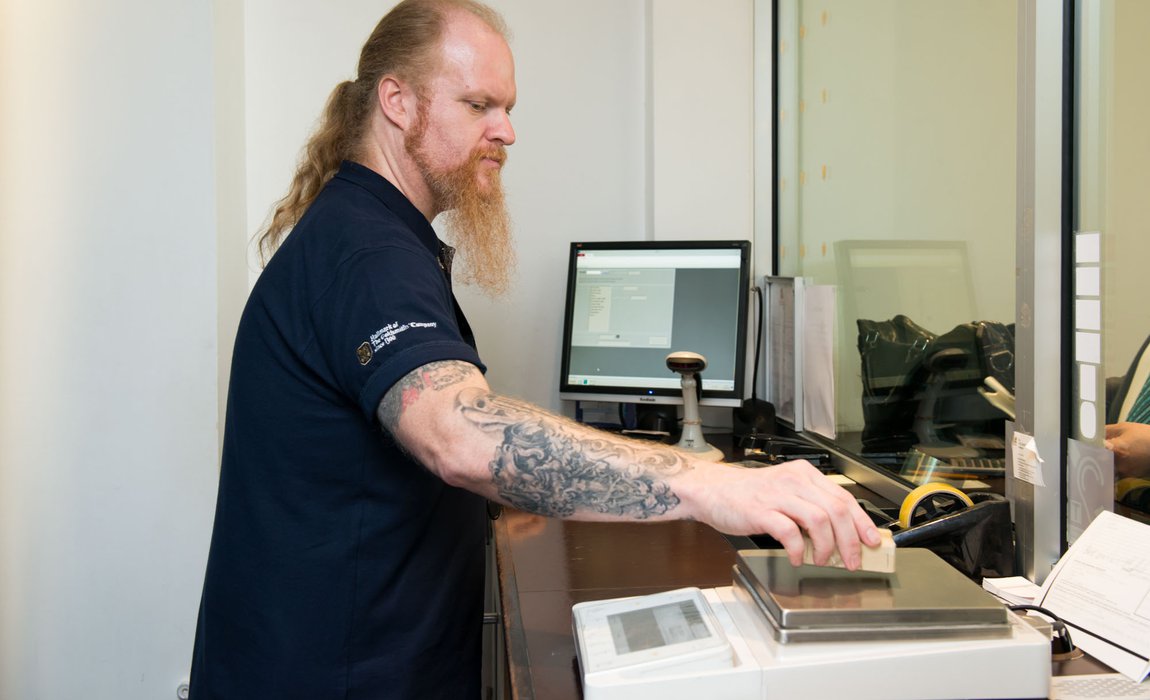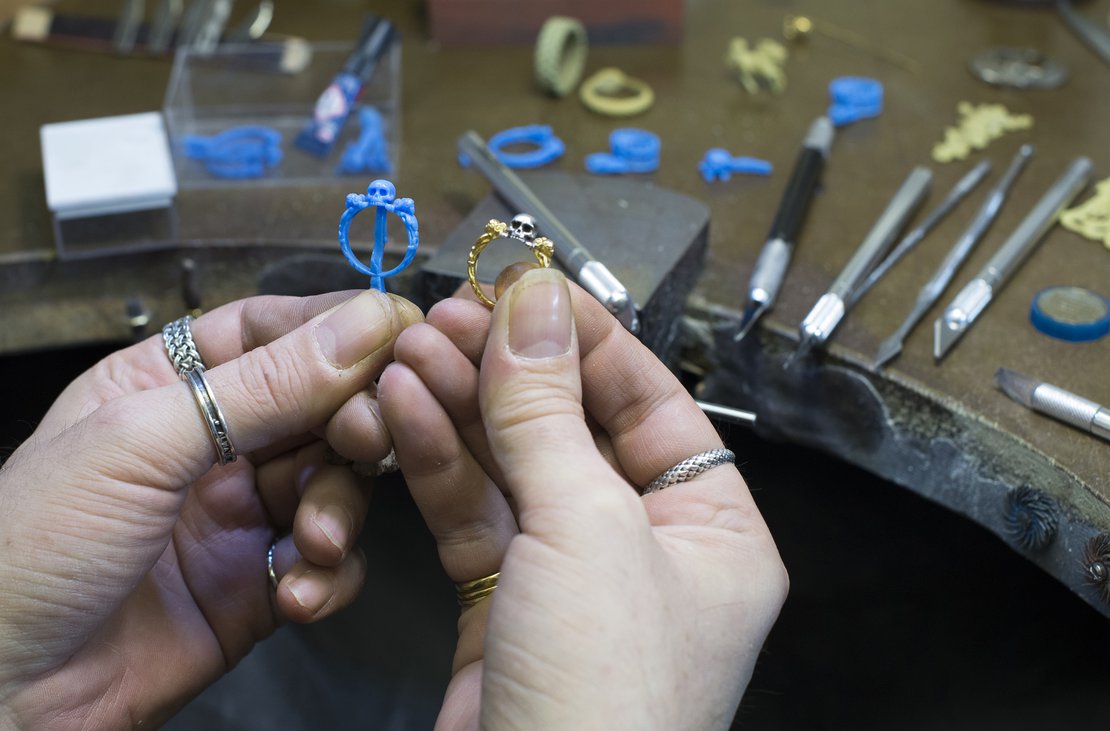Assay Office Technician
An Assay Office Assistant is a person trained and employed to test (assay) and appropriately hallmark after the determination of the presence and amount of precious metals (gold, silver, platinum, palladium) within an object.

The testing of precious metal can be done using a touchstone, cupellation, titration or XRF machine and, if the object passes the assay(ing) (testing), it can be legally ‘hallmarked’ ( hallmark(ing) ) by an Assay Office assistant following standard procedures, using a punch, press or laser.
“Hallmarking is Europe’s earliest form of consumer protection. In 1478, the first assay office was set up in Goldsmiths’ Hall, giving rise to the term ‘hallmark’. Craftsmen were required to bring their goods to the Hall for assaying (testing) and marking before they would be allowed to sell them within the City of London.”
What personal attributes are useful for an Assay Office Assistant?
To be an Assay Office Assistant, you need to be:
- Interested in working with precious metals
- Have good manual dexterity
- Patient and methodical
- Able to solve practical problems effectively
- Trustworthy and reliable – you will be working with someone else’s objects
- A good communicator with interpersonal skills – you might be explaining to customers why their objects have failed the assay (test)
Having a background in silversmithing or jewellery making is not essential, but it will help you understand how objects are made and how the metal might behave when you hallmark it. Being comfortable using silversmithing tools such as punches will also help. Part of your job will be to ensure customers are abiding by hallmarking legislation so attention to detail is important. Studying and understanding examples of fake hallmarks will help you better assess when objects are being used to deceive. Some assayers might be asked to test historic examples and it would be advantageous to be able to stylistically date objects and know something about the history of hallmarking.
What will my working life be like as an Assay Office Assistant?
Legally, you can only be an Assay Office Technician if you are employed by an Assay Office . There are very few Assay Offices in the country (London, Edinburgh, Birmingham, Sheffield or Dublin), but they have a long history and close relationships to the silversmithing and jewellery trade; the London Assay office has been in the same location since 1478. As an employee you will have a fixed working schedule, normally from Monday to Friday and may be asked to work additional hours during busy periods such as in the run up to Christmas.
Many people who work within an Assay Office will normally specialise in a specific department or skill. This could include metal sampling, hand-marking, press-marking, laser-marking, customer packet control or working on the customer counter focusing on logistics and registration. This means you will be working mainly in a workshop, laboratory, or on a counter and will normally work from a work bench. Depending on the type of work you are doing, may mean you regularly use a computer, technology, machinery and hand tools.
Within your work you must be able to adhere to industry health and safety requirements; know how to safely store, handle and dispose of chemicals; know how to safely operate and maintain your machines and tools and learn how to process precious metals, their alloys and solders. You will find it useful to maintain a working knowledge of Hallmarking legislation. You can expect to work with all carats of yellow, red and white gold, platinum, palladium, silver, solders and combined metals. And you will learn how to use tools including a Touchstone, an XRF Machine, a laser engraver, various presses, hammers, mallets, stakes and punches. You should receive training in all of these, as required.
A day in the life of an Assay Office Assistant
 On the Customer Counter at Goldsmiths' Hall Assay Office
On the Customer Counter at Goldsmiths' Hall Assay Office
 Weighing a customer’s packet
Weighing a customer’s packet
 Using Touchstone Keys to test metals
Using Touchstone Keys to test metals
 Grinding hallmarking punches to prepare them for use
Grinding hallmarking punches to prepare them for use
Ryan Grant from the Goldsmiths' Company Assay Office hallmarking the 'Apprentice Beaker'
 Working at Greville Street Assay Office
Working at Greville Street Assay Office
 Preparing to laser hallmark
Preparing to laser hallmark
Training or qualifications: How can I become an Assay Office Assistant?
There are several ways to start out in the jewellery, silversmithing and allied industries. To become trained as an Assay Office Technician you may choose to go straight into a job, or relevant course at a college, university or training centre. There are very few skill-specific qualifications available, but many courses provide an introduction to a range of creative skills. To find out more about different options and your potential route into a creative career within the goldsmithing industry click here. Whatever route you choose, legally, you can only be an assayer if you are employed by an Assay Office in London, Edinburgh, Birmingham, Sheffield or Dublin.
What can I earn as an Assay Office Assistant?
As an apprentice or someone who is training you should be paid at least the National Minimum Wage for your age and this rate should increase as you get closer to completing your training. Apprentices undertaking traditional training may start out earning around £13,000 – £15,000 per year and be closer to £18,000 – £20,000 at the end of their four-year apprenticeship. Once you have completed your training your earnings will vary depending on your skill and employment status.
Assay Office Technicians can legally only be employed by an Assay Office. Within the UK there are Assay Offices in London, Edinburgh, Birmingham, Sheffield or Dublin. Salaries for an employed Assay Office Technician with specialist skills can start at around £25,000 - £30,000 per year in the first few years after training. This can rise to £32,000 - £37,000 for employees who are multi-skilled or supervisors and can reach £40,000 - £70,000 for site and senior managers depending on the department they work for and their level of skill.
What industry membership bodies can I join?
The Goldsmiths’ Centre offer a range of membership options for people at different stages of their career. Joining a membership body or keeping up to date with industry events allows you to create a network with like-minded individuals. Keeping up to date with hallmarking legislation will be useful if you are interested in working for an Assay Office. See for example:
The Goldsmiths’ Company Assay Office
The Goldsmiths’ Centre
Association for Contemporary Jewellery
British Hallmarking Council
British Society of Enamellers
Cockpit Arts
Contemporary British Silversmiths
Craft Central
Crafts Council
Craft Northern Ireland
Guild of Enamellers
Hand Engravers Association of Great Britain
Incorporation of Goldsmiths
Institute of Professional Goldsmiths
National Association of Jewellers
Sarabande
Scottish Mineral & Lapidary Club
Society of Jewellery Historians
The Silver Society
Meet the makers

"I have a unique opportunity to see and handle many antique and contemporary items made from Gold, Silver or Platinum which have been produced by some extremely talented craftsmen and women."
Examples of assaying
 Hallmarking key 2019
Hallmarking key 2019
 Master Pattern for leopard’s head Town Mark
Master Pattern for leopard’s head Town Mark
The Goldsmiths’ Company Collection includes over 8,000 pieces of antique, domestic & contemporary silver, jewellery and art medals which were made in Britain between 1350 and the present day. The Company continues to purchase, and commission pieces each year and new contemporary pieces must demonstrate innovative design combined with excellent craftsmanship. Pieces are acquired from both established craftspeople and rising stars.
 Stuart Jenkins' rings © Julia Skupny, The Goldsmiths’ Company Assay Office, 2019
Stuart Jenkins' rings © Julia Skupny, The Goldsmiths’ Company Assay Office, 2019
 Tom Tudor-Pole, Leopard Head Dish, 2009 © Collection: The Worshipful Company of Goldsmiths
Tom Tudor-Pole, Leopard Head Dish, 2009 © Collection: The Worshipful Company of Goldsmiths
 Leslie Durbin, Paperweight, 1977 © Collection: The Worshipful Company of Goldsmiths
Leslie Durbin, Paperweight, 1977 © Collection: The Worshipful Company of Goldsmiths
 Leslie Durbin, Paperweight, 1977 © Collection: The Worshipful Company of Goldsmiths
Leslie Durbin, Paperweight, 1977 © Collection: The Worshipful Company of Goldsmiths
 Stuart Devlin, Caddy Spoon, 1967 © Collection: The Worshipful Company of Goldsmiths
Stuart Devlin, Caddy Spoon, 1967 © Collection: The Worshipful Company of Goldsmiths
 Stuart Devlin, Caddy Spoon, 1967 © Collection: The Worshipful Company of Goldsmiths
Stuart Devlin, Caddy Spoon, 1967 © Collection: The Worshipful Company of Goldsmiths
Further information
There are many reputable sources of information relating to the jewellery, silversmithing and allied industries. Whether you are trying to find information on technical skills, processes, materials, makers or inspiration some resources relating to Hallmarking can be found below:
The Goldsmiths’ Company Library relates specifically to gold and silversmithing, jewellery, assaying and hallmarking, precious metals, and the City of London and its guilds. The Library includes 8,000+ books and 15,000+ images, magazines, periodicals and journals, technical guides, films, special research collections, design drawings produced during the early and mid-twentieth century by British or UK-based craftspeople and subject files on a wide range of industry related topics. The Library is also responsible for the Company’s archives, which date back to the 14th century.
Hallmarking related books include:
- Prof. Dr. Erhard Brepohl, The Theory and Practice of Goldsmithing, Maine, Brynmorgen, 2001
- J.S. Forbes, Hallmark: A History of the London Assay Office, London, Unicorn Press, 1998
- Mark Grimwade, Introduction to precious metals. Metallurgy for jewellers & silversmiths, Maine, Brynmorgen Press, 2009
- Ian Pickford, ed., Jackson's Silver & Gold Marks of England, Scotland & Ireland, Woodbridge, Antique Collector’s Club, 1989
Hallmarking related video content includes:












